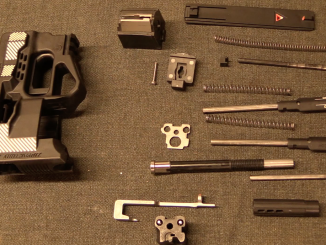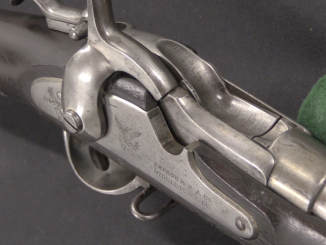Greenland is a remote and desolate land without a significant industrial base, but there is a demand for hunting rifles there. As the place has long been a Danish colony since 1814, its trade was restricted to Denmark – including rifles. The Danish military received a substantial number of M1917 Enfield rifles in .30-06 caliber, and they were used by the Danish Home Guard after World War Two until being eventually sold as surplus. Some of those surplus rifles were modified by the Greenland Trade conglomerate (“Kalaallit Niuerfiat”) and sold as commercial hunting rifles.
The conversion pattern used was to mill off the rear aperture sight and replace it with a fixed open notch dovetailed into the chamber area of the barrel. A new front sight was installed to match the height of the rear notch, and the bayonet lug was ground off for some reason. This particular example was originally manufactured in 1917 and used by the Canadian military before being sent to Denmark and eventually sold as surplus.
The M1917 was the standard rifle for the Sirius Patrol, a Greenland military force established during World War Two to prevent establishment of German outposts on Greenland (and very effective in this work). The force still exists today, and still uses M1917 rifles, now paired with 10mm Glock 20 pistols. The commercial sporterized M1917s like the one in this video are not made from Sirius Patrol rifles, however.
Thanks to the Southern Iceland Shooting Association for helping me film this and other cool guns in Iceland!




I wonder if these rifles were used by Canada in WWI? I have never seen photos of Canadian troops with M1917s. I could imagine them being used in WWII as some sort of Home Guard or training rifle. Otherwise, Canada used .303 weapons, and I doubt they would have wanted to introduce 30.06 into their system.
It is sad to see the excellent M1917 rear sight ground off and replaced by a fixed rear notch sight, even if there was a reason for it. And the notch is so small! I guess the Inuit hunters in Greenland have not ruined their eyes looking at screens.
A really interesting insight into a rifle with a lot of history behind it.
As seen in Finnish Brutality, aperture sights can get jammed up by snow. Necessity is a mother, etc.
From wiki, ‘They (M1917 rifles) were initially allotted to Canadian Army Basic and Advanced Training Centres, the Royal Military College of Canada, and Canadian Army (Reserve) units. They would also be issued to the Veterans Guard of Canada, the Pacific Coast Militia Rangers and the Royal Canadian Air Force. The M1917 would fill a critical role in Canada’s war effort, freeing .303-calibre weapons for front-line use or to be supplied to the UK after Dunkirk, when Canada provided 75,000 Ross Mark III rifles beginning on 22 May 1940.’
As late as 2010 the Canadian Ranger Patrol Groups used Lee Enfield No. 4 rifles
Notice people out in the boonies like 10MM Pistols?
this is the only time I’ve heard of the Glock 20 being used by a military (not police) force as an issue weapon.
Canada purchased, not Lend Lease, c100,000 US M1917 rifles in 1940-1. These were used by Cdn Army training units, veterans guard, non mobilised Militia and RCN and RCAF.Post war many M17s were shipped to Denmark from Canada.
Bruce:
Pretty much as I thought. I did not think Canada would have used M1917s in WWI. The USA had greater need of them then.
My late father insisted that P17s were the most accurate rifles in their class. Retired Canadian Army Reserve Major Edson Warner CD must have known a thing or two about rifles since he won five Queen’s Medals for shooting competitions at the Connaught Ranges.
Robert:
Strictly speaking, the American 30.06 rifles are M1917s. The P14 was the British .303 version of the rifle, so there is no such thing as a P17.
If you cannot be a firearms pedant on this site, where can you be?
Actually, “Pattern 14” refers only to the original .276in prototype series. The 0.303in was properly the Rifle Pattern 1916, 0.303in, Non-Interchangeable (i.e., parts were not usable on SMLEs).
See Hogg & Weeks, Military Small Arms of the 20th Century, 4th ed.
cheers
eon
Top pedantry, I salute you.
Eon:
I have been looking at my copy of Hogg & Weeks, 6th edition. They state that the Pattern 14 was originally in .276, but that the .303 versions were also termed Pattern 14, or P14, either Mark 1E, 1R or 1W, depending on where they were built, Remington Eddystone, Remington Bridgeport or Winchester. All three types were formally adopted on 21st June 1916, but were termed as Pattern 14, not Pattern 16.
What distance is this hunting rifle conversion zeroed for? I’m guessing 100 meters, but is that correct?
I’m betting that the bayonet lug was milled off to demilitarize the Enfield.
Does the charger guide (clip slot) still function? That rapid reloading feature, bayonet lug with handguards over the top of the barrel, stacking swivels, and the long-range military sights made the M1917 a battlefield weapon–the battle sight was 400 yards and the range-adjustable ladder sight went from 200 to 1600 yards. Or did the slider go down to 100 yards? I’ve seen photos of both rear sights and it’s been 40 years since I’ve owned a Model 1917.
The Sirius Patrol has a particular status in Danish psyche. The number of volunteers for it vastly exceed the positions available each year. The main role of the M1917 is to kill seals for food for the dog sledge team. The ten mm has frequently proven itself in use against marauding Polar Bears with a taste for Husky flesh, the standard use being to shot and keep on shooting until it does not move anymore. After the Hippotomus, the Polar Bear is the most dangerous land animal. A deceased now brother in law used to tell of killing a Polar Bear which had just killed four “Men of the North” on the East side of Hudson’s Bay, every round of his Winchester 30.06, the ,45 Colt killed before it killed him. He in the Royal Canadian Mounted Police, my far older sister who had married him at the war’s end (he in the RCMP MP Company) used to tell of carrying a 12 gauge pump with buckshot in one arm, baby in a papoose on her back hanging the washing out, and she used it. On final retirement they went to Bermuda, with two well preserved Polar skins on the wall, a great conversation piece. Then as now Polar Bear are rife in that area.
Difference between polar bears and hippopotamus killing you is that the hippo isn’t well-documented as actually seeking out human prey; it’s usually down to someone wandering into their territory. Polar bears, on the other hand? They’ve been known to go out hunting for humans about the same way they go after seal.
One’s an active threat, the other is misadventure.
That said, I’d be curious to see what transpired when/if there was ever a match-up between a hippo and a polar bear… I suspect that would likely be something to see.
My stepdad had pictures he’d taken up in Alaska when he was a cook on a fishing boat; one day, they saw a female polar bear and her cubs out swimming like it was any other day, totally routine. Out of sight of any land; there were some ice floes nearby, however… A pod of killer whales showed up, apparently with the idea of bear sushi.
Things did not go the way the whales planned. Last they saw of bear-and-whale, there was a cub on an ice floe, and this polar bear clamped onto the back of a desperately sounding killer whale, with said bear gnawing away at the whale’s blowhole with murderous intent, blood everywhere in the water, and the rest of the pod circling the whole thing in complete confusion. They never did see the denouement of it all, but when they left the area, the bear was winning…
It was one of those stories I’d have written off, but he had pictures of the bear on the whale’s back.
so how would the M1917 stack up against the SMLE or the No IV in .303?
Noting the Canadians had a unit equiped with the No IV (I think) until quite recently?
The unit eqipped with the No.4 rifles being the Canadian Rangers mentioned above by JPeelen. Which are quite similar to the Danish Sirius Patrol as they patrol the empty regions up north and west of Canada. The No.4 serving pretty much the same purpose as the M1917 rifles. Self defense against wildlife and hunting for food. The Canadians changed to new C19 rifles starting in 2018. Those being a variation of the Tikka T3x rifle. To circle back to Greenland I bet Denmark is going to buy a very similar model for replacement.
In use they are pretty much interchnageable, although many M1917 were menufsftured with wider clearances/tolerances. So they should work better in arctic weather.
Personal memoir, RIDGE RUNNER from the bill piney to the battle of the Bulge by Norman Dablemont. He tells of not being able to see anything with an M-1 peep sight so he filed a notch in the top and qualified as Marksman. Then they nearly court marshaled him for destroying gov. property. He got busted to sharpshooter and had to pay for the rifle.
Curiously, a friend told me he had the same field of vision problem while deer hunting with an M-1. He finally guesstimated where the deer was and took a shot. when he went for the carcass,, he noted his bullet had gone through a sapling branch. He figured that had corrected for his bad aim.
I used to own a P17 and a sporterised SMLE.
Thy’ve all been sold!!!